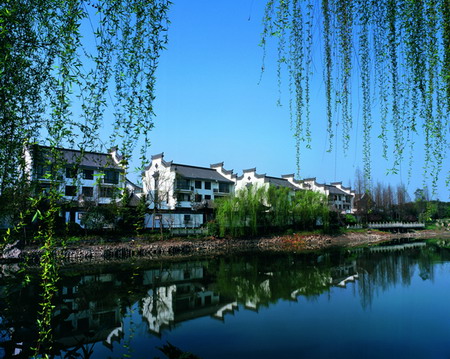Wenjiang: True model of ‘Better City, Better Life’
Updated: 2010-04-30 16:08
|
|||||||||||
 |
|
Rivers and trees are key elements in Wenjiang’s urban design that create a better environment and give the city a sense of life. |
With the theme “Better City, Better Life”, the 2010 Shanghai World Expo opens on Saturday in Shanghai.
Posters with the slogan are everywhere, so Expo visitors might ask the obvious question —“where are the better cities in China that offer a better life?”
The list might be not too long, but Chengdu, capital of southwest China’s Sichuan province, is no doubt near the top.
Situated at the heart of the Sichuan Basin — widely known as “the land of plenty” — Chengdu’s quality of life was recognized by the UN when it was placed in the organization’s Habitat Scroll of Honor in 1998.
The city is heading toward modernization at a steady pace and in a composed manner, allowing its people to benefit from the material gains in a sustainable, growing economy while enjoying the fruits of a millennia-old civilization and well-preserved natural environment.
A role model
Wenjiang district, a newly urbanized area west of downtown Chengdu, is now seen by locals as a model of how to create a better life for residents.
With an area of only 277 sq km, a population of 338,400 and a gross domestic product of 17.1 billion yuan in 2009, Wenjiang’s administrators are not keen to promote themselves with just surging statistical figures.
Authorities and residents want the district to be a harmonious combination of prosperity and serenity, modernity and ancient heritage.
Wenjiang has a long history. Recent archaeological discoveries show it was the capital of the ancient Shu Kingdom some 4,000 to 5,000 years ago.
Agriculture has flourished in the area for more than 2,000 years, making it one of the best places to live in China throughout its history. The nearby Dujiangyan Dam built at the upper reaches of the Minjiang River during the Warring States Period (475 BC-221 BC) is the nation’s greatest ancient water control and irrigation system, and one that still works today
The district is still a shining example of good living and business environment as a result of well-positioned plans by local authorities for urban construction and economic development.
While most Chinese cities, especially western cities, are attracting investors to launch big manufacturing projects, Wenjiang chose a different path.
As the district covers only 277 sq km, authorities didn’t think it has enough space to host big production facilities. Manufacturing projects also inevitably cause pollution, so planners turned their sights to the service industry to augment traditionally prosperous agriculture.
And the approach to agriculture is totally different from decades ago. Planners don’t want to develop grain-intensive production on such a small piece of land, so they decided to grow specific varieties such as flowers and vegetables to meet the demand of Chengdu and other neighboring big cities.
The district now has more than 8,000 hectares of flower farms, about one-third of Sichuan’s total.
Quality, rather than quantity, is emphasized, with “organic and pollution-free” the buzzwords.
Living environment
 |
|
Many of the residences in the area are built in traditional style — two or three-story with white walls and grey roof tiles. |
As with many areas in China, Wenjiang district is in an inevitable process of rapid urbanization.
In 1985, the urban area of Wenjiang was less than 2 sq km, with about 30 streets. Last year, the urban area reached 28.6 sq km, with more than 150 streets and 173,000 residents.
Yet avoiding problems from rapid urbanization such as a worsening ecology and deteriorating living conditions is a top concern of the local government.